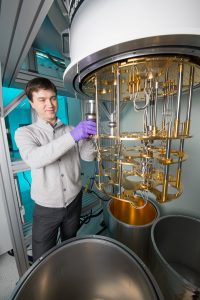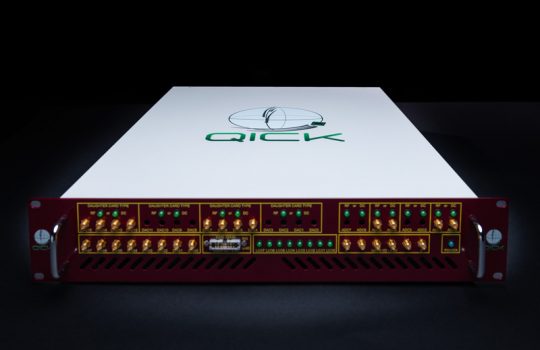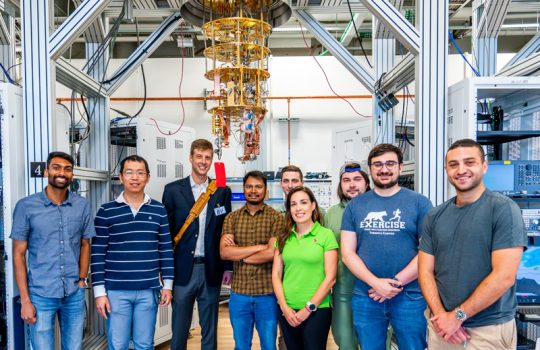
Alex Romanenko prepares to cool superconducting accelerator cavities, the silver-colored objects, to convert it into a quantum device. Photo: Reidar Hahn
Some of the most exciting advances in modern scientific research are in the field of quantum science and technology. Among them is quantum computing, a novel data-crunching technique that could revolutionize everything from biochemistry to codebreaking.
The Department of Energy’s Fermilab is positioning itself to be a forerunner in the hugely exciting field, with a new lab on site dedicated to its research and development. Favorable to Fermilab is its expertise with particle accelerator technology, which scientists are now adapting to produce game-changing quantum systems. Specifically, the superconducting radio-frequency (SRF) technology developed at the lab could help push quantum computing into a new realm.
As part of the DOE Office of Science Quantum Information Science-Enabled Discovery (QuantISED) program, a consortium of three institutions under the leadership of Fermilab scientist Alexander Romanenko has been awarded $3.9 million over two years to further SRF technology for quantum science, potentially boosting the processing speed and storage capacity of quantum devices, including quantum computers and sensors.
Beyond binary
The device you’re reading this on right now is based, at the lowest levels, on binary code – 1s and 0s. Each 1 or 0 is called a bit, and this has been the basis for all computing, right from the very first prototypes in the early 20th century. But quantum computing works differently, by exploiting strange effects that arise at the subatomic level, such that a quantum bit – or qubit – can exist as a combination of both 1 and 0.
A big stumbling block with current attempts at quantum systems is keeping this fragile superposition of 1 and 0 stable long enough to make it useful. Leading groups have managed to maintain superpositions in quantum computers for only a few milliseconds, which severely limits the potential applications of the technology. Fermilab scientists, along with collaborators at the National Institute of Standards and Technology and the University of Wisconsin – Madison, are aiming to make a big improvement on that, keeping the systems stable much longer, up to a few seconds at a time.
“The longer this stability time, the more you can do with a quantum computer. If it’s very short, you can do nothing,” said Romanenko, head of SRF technology at Fermilab. “We’re aiming to stabilize it for substantially longer than the current best. That’s the big impact we’re after.”
Home advantage
With 50 years of experience operating particle accelerators, Fermilab is home to some of the world’s leading experts in accelerating technologies, including structures called resonating cavities that use extremely low-temperature SRF technology to boost particles as they pass through them.
“Here, we really have among the best experts worldwide in different areas all together, so we are the place where integration can occur. That’s the exciting thing,” said Anna Grassellino, Fermilab scientist and deputy head of the lab’s Applied Physics and Superconducting Technology Division.
By lowering the energy of its electric and magnetic fields and operating it at near absolute zero temperatures — thousandths of a Kelvin — an accelerating cavity can be converted into a quantum device.
A special computer chip – essentially a tiny electrical circuit – is placed inside the cavity. The circuit is made of a special material that, at extremely cool temperatures, allows pairs of electrons to flow freely around — to superconduct.
The surrounding cavity gives the chip a pulse of photons, transferring a tiny amount of energy to the electrons in the chip’s circuit. But because this all takes place in the strange quantum world, the electrons become both energized and not at the same time – a superposition. Together, the chip and the cavity represent a single qubit.
A further pulse then allows the scientists to gain information from the chip.
If some of the energy of the pulse is absorbed by the cavity walls, the quantum superposition collapses, and the quantum computer becomes useless, which is one of the major problems faced by quantum groups. One of the key reasons Fermilab may be able to produce quantum systems that last longer than any other is the specialized manufacture of the cavity itself, which reduces pulse absorption and was developed at the laboratory.
“Fermilab is one of the world leaders in SRF technology,” said Fermilab Deputy Director Joe Lykken. “That’s why our research has delved into this quantum world — because we know we can make an impact based on our unique strengths in these and other areas.”
A quantum future
Quantum computers are not likely to replace current technology any time soon. The techniques are not directly comparable, and while a quantum approach is better suited for carrying out certain tasks, classical computing still maintains advantages.
“Quantum computing is different, not always better,” Romanenko explained.
The tasks that quantum computing could excel at include simulating the quantum systems that underlie high-energy physics. With its superposition advantage, a quantum computer may be able to carry out many more calculations in a given time than a classical system, rendering complex codes breakable and protein-folding far easier to model.
The quantum technology under development at Fermilab even has potential applications outside of computing. Fermilab is developing quantum sensors, such as the high-quality cavities, to detect candidate dark matter particles called dark photons.
These future possibilities may not even be too far off. The team behind the quantum effort are optimistic about the timescale.
“If all goes well, there should be the world’s best superconducting qubit here in just a few months,” Romanenko said.



